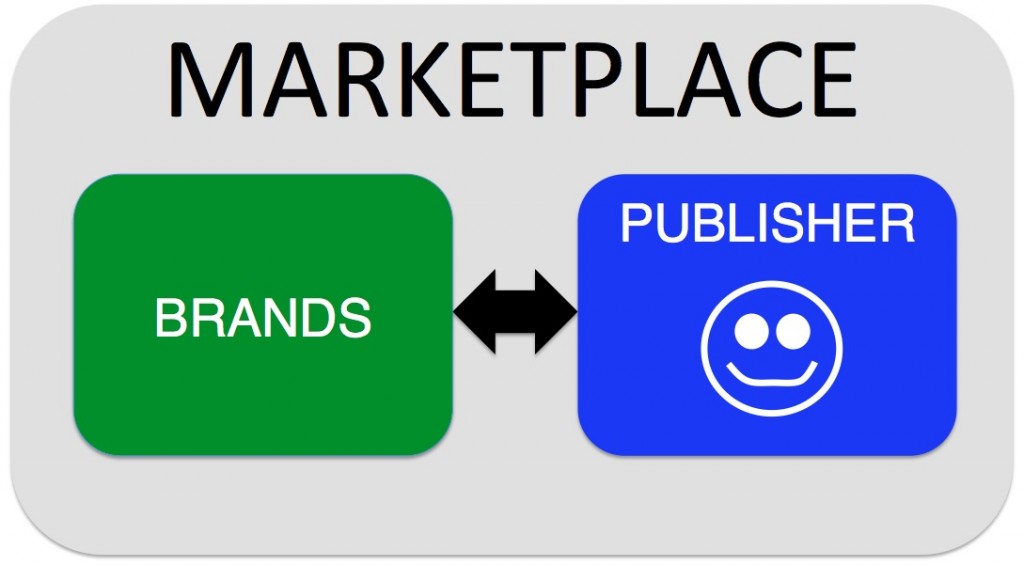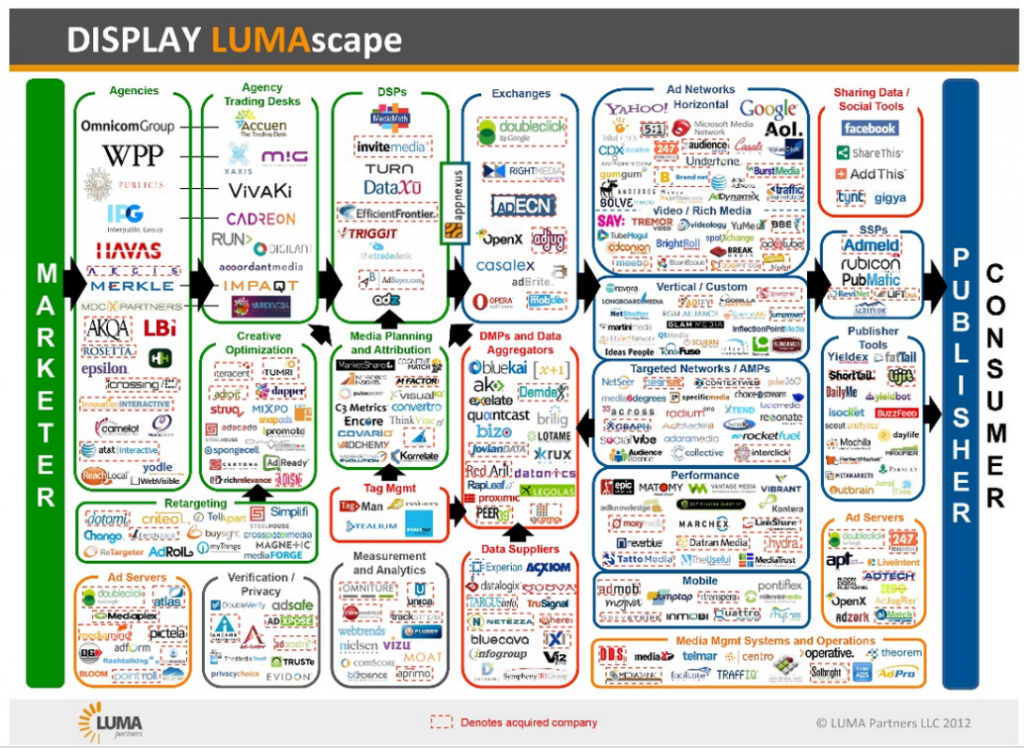Two positive pats on the VRM back greeted the new year and got me thinking.
The first is Jim Harris’ Small Data and VRM — his prediction for 2013 in the @DataRoundtable blog. He writes,
One of the reasons that vendors are getting geeky over Big Data is because they claim that they want to use it to become more customer-centric and better understand customer behavior when, in reality, what vendors really want is to become more customer-captive and better control customer behavior.
However, the alternative to each individual vendor using Big Data to collect and manage HoardaBytesof information about multiple customers is to invert the one-vendor-to-many-customers paradigm by embracing a one-customer-to-many-vendors paradigm. Individual customers would own and manage the Small Data needed to accurately describe themselves, protect the privacy of their data and decide for themselves how their data – and how much of their data – is shared with vendors.
My lament over vendors historically not allowing us to own our own data, which I have been referring to as the Fundamental Flaw of Customer MDM since 2010, is a topic I return to on a regular basis, including my recent blog series about social MDM that received some thought-provoking commentary, among which was an excellent book recommendation made by Jean-Michel Franco.
… and then quotes The Intention Economy for several paragraphs before concluding,
The status quo will always fight the future, but change is the only universal constant. I hope 2013 will see the beginning of the changes – almost none of which are technological in nature – needed to bring about this long overdue paradigm shift in data and customer relationship management.
Keith Teare in Techcrunch sees the same changes coming, and visits them at length in Unnatural Acts and the Rise of Mobile. Here’s a compressed version of his post:
There is a new law emerging in cyberspace. As desktop traffic growth declines, and mobile adoption explodes, predatory marketers need to monetize mobile traffic or die trying.
As this law takes hold, bad behavior is replacing smart long-term product thinking. The result is an explosion of unnatural acts of engagement. Facebook allows users to escape its filters (designed to give a good experience) by paying to force their Facebook posts in front of their friends — $7 a time and you’re golden. Twitter sends constant reminders about “what you missed” on its service. Google Plus has notification defaults set to a level that results in constant stream of inane emails.
Users are the net losers in this festival of lowering the bar when it comes to how badly behaved a marketer is permitted to be in order to drive use…
The possibility exists in 2013 that the absolute revenues of the major players will decline as desktop revenues suffer and mobile revenues fail to make up the difference, even as they grow dramatically. This nightmare scenario is key to understanding what is driving bad behavior by marketers and product leaders. Bradley Horowitz recently made some pretty good jokes about Facebook’s bad behavior, but Google is not immune from this disease…
The need to monetize mobile traffic will dominate Google, Facebook, Twitter and others in 2013. And the pressure is to do it quickly due to the collapse in the growth of desktop-based traffic. Successful CMOs will avoid the pitfalls of driving unnatural acts of engagement and focus on user-benefits derived from monetization strategies…
I have lost count of how many ads offering me products that I have already purchased have flown past me on various sites and devices recently. Even the ad stream is becoming polluted. Targeting efforts are at the bottom of this trend. But from a user point of view targeting is poor and therefore irritating. The recent attempt by Facebook to alter the Instagram terms and conditions, and privacy policy, was a mistake, and acknowledged, but nonetheless it was driven by these desperate efforts…
currently all roads point to several varied attempts to re-portalize; that is to say, to own your own traffic and seek to monetize it. This is the old Yahoo view of the world and it clearly represents a limited mindset that will not scale to the huge mobile opportunity. For Twitter in particular, which has a large global opportunity as a platform, this trend represents a shrinking of its real opportunity…
Advertising is so far disappointing both in terms of its scale and its growth trajectory, as well as the value of a CPM. This disappointment forces mobile marketers to either innovate in the meaning of advertising on mobile or to systematically force feed both a large volume of ads, as well as attempt to target those ads in such a way that higher CPMs can be achieved. Everybody becoming an advertiser and paying for one’s attention is one way we see this. Limiting the distribution of a post, and then incenting payment for the post to be seen, is the ultimate in bad behavior. It won’t work out well…
Intimacy and long-term relationships are a forgotten goal.
The essence of good behavior is to start by helping the user achieve a goal. The essence of a mobile device is that it is intimate… The short-term revenue win from displaying an ad is offset by the long-term relationship damage done between the user and the publisher showing the ad. The sense of being a “target” rather than a person is a growing experience, as our sensibilities are increasingly offended…
The net impact of desperation-driven bad behavior is that users become cynical of publishers they formerly embraced. Privacy invasions, behavior changes by apps, and other experiences lead to the assumption that we, the users, are nothing more than ad fodder. The sad thing here is that users want their favorite publishers to make money, so that they can fund the app or service in question. But the crude methods of monetization are leading to alienation, not love…
The real nightmare for the industry here is that advertisers also become cynical. Upsetting users is not high on the list of advertisers’ goals. As users react, advertisers will run in the opposite direction. The already slow growth of mobile advertising will slow even further and the already large gap between the hours spent on mobile and the advertising dollars focused on it will grow further. Nobody wants this, but everybody is fuelling it. It is time to take a deep breath and collectively think about how to have the opposite impact…
New apps and services can grow quickly by offering intimacy and control to users.
Intimacy is the currency on mobile. Intimacy is a great thing, of course. Users love the ability to engage with those they like, love, and admire, and even those they hate and detest, in a personal mobile space. Apps that feed or empower this intimacy have prospered. Apps that trample over it have suffered… Mobile is 100 percent intimate, and bad behavior – and I include targeting here – will fail to produce scalable revenues. Doc Searls, in his Vendor Realtionship Management thoughts, has captured much of this thinking. His book “The Intention Economy, When Customers Take Charge” is a must-read book for the class of 2013 CMOs…
I definitely long for an unpolluted stream that is 100 percent capable of telling me things I want to be told. I also would love a way to tell the advertisers which brands I love, whether it be my favorite airline, movie theater, restaurant, camera vendor or whatever. I would love a way to regulate or control how my favorite vendors interact with me. Throttling them when they send too much or the wrong stuff, killing their ability to reach me when they behave badly, embracing them when they serve me well. Mobile, as an intimate device, is a great area to place the controls needed to realize much of this. And it scales too. Every human being on the planet has intimate tastes and relationships they love. This is true for their relationships to people, brands, products, organizations, and other entities. Two billion smartphones by the end of 2013 and every entity on the planet makes for a very large opportunity to allow users to become the boss, and for brands to enter into adult relationships with the customers who love them. Mobile is the perfect platform for the dream of one-to-one marketing to finally exist.
Markets are dance floors. If marketers want to dance one-to-one with customers, they need to let customers take the lead at least half the time. Here’s what I say about that in a chapter of The Intention Economy titled “The Dance”:
Right now, most retail market categories are dance floors where every customer hears dozens, hundreds, or thousands of companies, each with a megaphone, calling out dance moves. What those companies need to do instead is put down the megaphone, and—in the manner of Trader Joe’s and Zappos—shop along with customers. Dance. Sure, lead sometimes, but follow, too.
Not easy. Throughout the industrial age, business on the whole has always taken the lead—or thought it had to. But for customers to take charge—which they will, at least half the time—they have to take the lead, too.
It helps that vendors and customers both bring qualities to the dance floor that the other does not, and that both need each other for the economy to work and for civilization to thrive. They don’t always need to love each other or even to know each other. But they do need to respect, understand, and learn from each other. They can’t do that to full effect if one side tries constantly to dominate the other.
One thing companies are free to do is please and delight customers with products and services that are truly worthwhile. The chances of doing that only go up if customers are both heard and engaged as equals, and not as slaves or suckling calves.
So if you, Mr. or Ms. CMO, want to dance with customers, start by taking a look at the VRM developments that are already underway, because they’re supplying the dance shoes customers are starting to wear. (In some cases, such as browser extensions for blocking ads and tracking, the shoes have cleats, and customers are putting them on to run away from you.)
If you, big data masters, want to truly understand customers, do two things: 1) Look in the mirror. There you’ll find a human being who will never be fully described by data of any size — least of all by data gained by unwelcome surveillance; and 2) Give people, especially customers, the data you have about them. Remember what happened to computing with PCs and communications with the Net: individuals could do far more with both than could any big companies — least of all ones that thought they could do it all with big centralized systems.
If you, investors (and investment-focused media such as Techcrunch), want to ride a true sea change rather than surf the next buzz wave, consider this: VRM is about equipping the entire buy side of the market with its own tools of engagement — tools that can signal true intention, good will and countless other forms of economic signaling. This was a promise from the start of personal computing, of the Net, and of mobile devices. Rather than looking at those things as ways to target, capture, drive, trap, own or lock in customers, look at them as ways for customers to reach out and engage you, in their own ways and on their own terms. Remember that customers are where the money that matters comes from. They’re also the ones in the best position to keep it mattering, by exercising genuine loyalty, rather than the kind coerced or enticed with gimmicks like loyalty cards, rewards and discounts.
And happy new year.





